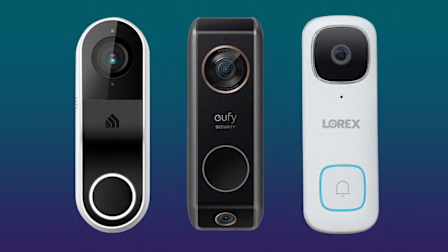Which Ring Doorbell Should You Buy?
Amazon’s home security brand sells eight different video doorbells. CR’s tests reveal big differences in video quality and responsiveness.
When you shop through retailer links on our site, we may earn affiliate commissions. 100% of the fees we collect are used to support our nonprofit mission. Learn more.

Thirty percent of American households own a video doorbell camera, according to a recent CR survey. And about half of those are made by Ring. These days, Ring isn’t producing the highest-rated models in CR’s video doorbell ratings, but the company does make solid products, and if you’re in the market for a Ring doorbell, you’ve got plenty of company.
But there’s just one problem. Ring offers eight different doorbells, designed to fit every budget and type of home, and those options can seem overwhelming. Which one do you choose?
Before we get into the differences, let’s start with what these doorbells have in common. Core features for every Ring model include Two-Way Talk, which allows you to speak with visitors; Quick Replies, which are recorded messages that play shortly after someone rings the doorbell; and Motion Zones, which allow you to highlight areas where you want alerts (say, a walkway) and block out areas where you don’t (such as a busy street).
- What Are the Differences Among Ring Doorbells?
- Ring Doorbell Reviews: Ring Battery Doorbell Plus Ring Battery Doorbell Pro Ring Peephole Cam Ring Video Doorbell (2nd generation) Ring Video Doorbell Elite Ring Video Doorbell Wired Ring Wired Doorbell Plus Ring Wired Doorbell Pro
- Which Ring Doorbell Is the Best?
- How CR Tests Video Doorbell Cameras
What Are the Differences Among Ring Doorbells?
Ring’s video doorbell models vary in a number of features. But the biggest differences are the power source, the video aspect ratio, and whether they can connect to a home’s existing doorbell chime.
Power Source
Video doorbells can run off batteries or be hardwired to a home’s low-voltage doorbell wiring. About half of Americans have doorbell wiring, according to a nationally representative CR survey (PDF) of 2,070 U.S. adults conducted in November 2023.
If you can use doorbell wiring, you have the most options. Ring offers four wired-only video doorbells, and with the exception of the Ring Peephole Cam, all of Ring’s battery-powered doorbells can also be hardwired. If you need a battery-powered doorbell, you can choose from Ring’s remaining four doorbells. All but one use removable, rechargeable battery packs. That means you can buy spares to charge up and quickly swap out when a battery dies.
Video Aspect Ratio
Most Ring doorbells record video in a 16:9 aspect ratio. This makes it easier to see to the left and right of your door but can cut off the heads and feet of visitors, plus any packages sitting on the ground. To overcome these drawbacks, Ring has started using a square aspect ratio, called Head-to-Toe Video, in some of its products. This square video has a fish-eye lens to help you see directly above and below the doorbell and spot packages, but it doesn’t let you look as far to the left and right.

Ring Ring
Doorbell Chimes
All but two Ring doorbells can make use of your home’s existing wired doorbell chime, as long as the doorbells are hardwired, too. The two exceptions are the Ring Video Doorbell Wired and Ring Peephole Cam. None of the Ring doorbells will work with another company’s wireless chime.
Ring makes two plug-in chimes that you can buy to use with any of its doorbells: Ring Chime, $35, and Ring Chime Pro, $60. The pricier model adds a built-in night light and a WiFi extender to improve the wireless connection for Ring doorbells and cameras. You can also use Amazon Echo smart speakers and displays as doorbell chimes.
Ring Doorbell Reviews
The eight Ring models range in price from $50 to $350 and provide a wide range of features—and performance. We currently have five of the doorbells in our ratings, and we will have test results for the remaining three soon. All eight models are listed here in alphabetical order with their key features, and test results where they’re available.
Ring Battery Doorbell Plus
The Ring Battery Doorbell Plus is one of the company’s newer models, and it performs well in our tests. It receives a strong score for data security and speedy response time, which means it sends alerts and loads live video feeds quickly. It also features the square Head-to-Toe Video and 1536p HD+ Video. That resolution is better than the 1080p HD video of other Ring doorbells, but in our tests, it receives just a midlevel score for video quality.
The doorbell can run off rechargeable battery packs or be hardwired for power. The latter also allows it to sound wired doorbell chimes. With a Ring Protect subscription, this doorbell gains cloud video storage, person alerts, and package alerts.
Ring Battery Doorbell Pro
The Ring Battery Doorbell Pro is Ring’s newest video doorbell and builds on the feature set of the Battery Doorbell Plus. Like that model, this doorbell also offers square Head-to-Toe Video and 1536p HD+ Video.
This doorbell’s big differentiator is 3D Motion Detection, which uses a radar-based motion sensor to detect movement more accurately. This feature also enables two others: Bird’s Eye Zones, which allow you to block out areas on a satellite map that cause false alerts (say, a busy street), and Bird’s Eye View, which shows you a breadcrumb trail on a satellite map of where people walked on your property. The Battery Doorbell Pro also features Pre-Roll Video, which shows you 4 seconds of black-and-white footage from before the doorbell detected motion.
The Ring Battery Doorbell Pro can run off rechargeable battery packs or be hardwired for power, and it can ring wired doorbell chimes. With a Ring Protect subscription, this doorbell gains cloud video storage, person alerts, and package alerts.
Consumer Reports is preparing to test the Ring Battery Doorbell Pro and will share the results soon.
Ring Peephole Cam
We haven’t tested the Ring Peephole Cam yet, but we have tested its predecessor, the Ring Door View Cam. That model was discontinued in 2021 and then resurrected two years later as the Peephole Cam. The two models seem almost identical, but we need to evaluate the new version to confirm.
The Ring Peephole Cam is unusual in that it replaces the existing peephole in apartment doors, essentially upgrading them with a doorbell button and a camera. It offers a claimed 1080p HD video resolution with a wide-screen 16:9 aspect ratio, as well as a knock detection feature to send you an alert if someone knocks on your door while you’re not home.
The Ring Peephole Cam can run only off its rechargeable battery pack, and it can’t ring wired doorbell chimes. With a Ring Protect subscription, this doorbell gains cloud video storage and person alerts, but not package alerts.
Ring Video Doorbell (2nd generation)
The Ring Video Doorbell (2nd generation) is the company’s least expensive battery-powered model, and despite the low price, it’s a good performer. It receives strong scores for data security, response time (to load alerts and live video feeds), and video quality. It has a claimed 1080p HD video resolution, but it uses a wide-screen 16:9 aspect ratio.
Unlike other battery-powered Ring doorbells, this model doesn’t have a removable battery pack. You have to take it out of its mount and recharge it using a micro USB cable. But it can be hardwired for power and can ring existing doorbell chimes. With a Ring Protect subscription, this doorbell gains cloud video storage, person alerts, and package alerts.
Ring Video Doorbell Elite
This model is designed for homes that use Power-over-Ethernet (POE) doorbells. That means it connects to the internet and receives power from an Ethernet cable rather than using WiFi and traditional doorbell wiring (though it can use WiFi, too). This doorbell has a claimed 1080p HD video resolution and wide-screen 16:9 aspect ratio, as well as Advanced Pre-Roll Video. This feature shows you 6 seconds of color footage from before the doorbell detected motion.
The Ring Video Doorbell Elite can be hardwired to ring existing doorbell chimes, but it can only receive power from a POE Ethernet cable. With a Ring Protect subscription, this doorbell gains cloud video storage and person alerts, but not package alerts.
We haven’t tested the Ring Video Doorbell Elite yet, but we plan to do so soon.
Ring Video Doorbell Wired
The Ring Video Doorbell Wired is the company’s least expensive doorbell, costing just $50 by itself or $70 with a plug-in Ring Chime. It performs well in our tests, offering strong data security and video quality, but its response time is on the slow side. It has a claimed 1080p HD video resolution and wide-screen 16:9 aspect ratio, as well as Advanced Pre-Roll Video that shows you 6 seconds of color footage from before the doorbell detected motion.
As its name suggests, this doorbell must be hardwired for power, but it can’t ring existing doorbell chimes. That’s why you’ll likely want the $70 bundle with the plug-in Ring Chime. With a Ring Protect subscription, this doorbell will also have cloud video storage and person alerts, but not package alerts.
(Also see my hands-on first look at the Ring Video Doorbell Wired.)
Ring Wired Doorbell Plus
Formerly known as the Ring Video Doorbell Pro, this model has been renamed the Ring Wired Doorbell Plus. It’s a decent performer in our lab tests, with high marks for data security and response time. But its claimed 1080p HD video leaves a lot to be desired, receiving an unsatisfactory score for video quality. The doorbell records video in a wide-screen 16:9 aspect ratio, making it difficult to see package deliveries, but it does offer Advanced Pre-Roll Video, which shows you 6 seconds of color footage before the motion event.
The Ring Wired Doorbell Plus must be hardwired for power and can ring existing doorbell chimes. With a Ring Protect subscription, this doorbell gets cloud video storage, Alexa Greetings, and person alerts, but not package alerts.
The Alexa Greetings feature lets Alexa answer the door for you and provide information or ask questions based on what your visitors say. A delivery person will be told where to leave packages, while a salesperson will be asked for pricing information and the types of services or products they provide.
Ring Wired Doorbell Pro
The Ring Wired Doorbell Pro, formerly known as the Ring Video Doorbell Pro 2, performs decently in our tests, but not as well as some of Ring’s less expensive models. It receives a strong score for data security, but its response time and 1536p HD+ Video receive just midlevel scores.
On a positive note, the doorbell features the square Head-to-Toe Video that allows you to see above and below the camera so that packages and visitors’ heads aren’t cut off.
Like the Battery Doorbell Pro above, the Wired Doorbell Pro features 3D Motion Detection, which uses a radar-based motion sensor to more accurately detect movement. In turn, this feature enables two others: Bird’s Eye Zones, for blocking out areas on a satellite map that cause false alerts (such as a sidewalk), and Bird’s Eye View, which shows you a breadcrumb trail on a satellite map of where people walked on your property.
The Wired Doorbell Pro also features Advanced Pre-Roll Video, which shows you 6 seconds of color footage from before the doorbell detected motion.
This doorbell must be wired for power and can ring existing doorbell chimes. With a Ring Protect subscription, you also receive cloud video storage, person alerts, package alerts, and Alexa Greetings. This last feature lets Alexa answer the door for you and ask visitors questions.
(Also see my hands-on first look at the Ring Wired Doorbell Pro.)
Which Ring Doorbell Is the Best?
Based on our tests, the best Ring doorbell overall is the Ring Video Doorbell (2nd gen), which ekes out a victory over the Ring Battery Doorbell Plus thanks to its slightly better video quality. Because the Video Doorbell (2nd gen) runs off batteries and can be hardwired, it’s a great option for homes with or without doorbell wiring.
But if you want a slimmer look without the chunky battery, your best bet is the Ring Video Doorbell Wired. It’s a little slower than its more expensive wired siblings, but its video quality can’t be beat.
Once we test the Ring Battery Doorbell Pro, Ring Peephole Cam, and Ring Video Doorbell Elite, we’ll update this article and see if there’s a new winner. We’re constantly testing new video doorbells year-round, so if you want to see the other models we’ve evaluated, head over to our complete video doorbell ratings.
How Consumer Reports Tests Video Doorbell Cameras
Our test engineers put doorbell cameras through several tests to see not only how well they work but also whether they do a good job of securing your data. These tests include how quickly a video doorbell sends alerts to your smartphone when motion is detected, how long it takes to load a live video feed of a visitor, video quality during the day and at night, smart features (such as person detection and voice control via digital assistants), and over 70 factors that inform our data privacy and data security scores.
The Smart IQ score takes into account the various smart features offered by video doorbells, allowing you to see at a glance which models offer more smart features than others. Notably, this score doesn’t include features that require a subscription. This tends to depress the scores for Ring doorbells, which require a Protect Plan subscription to access most smart features, such as person and package alerts.
For more information on our doorbell camera testing process, see our home security camera buying guide.
































